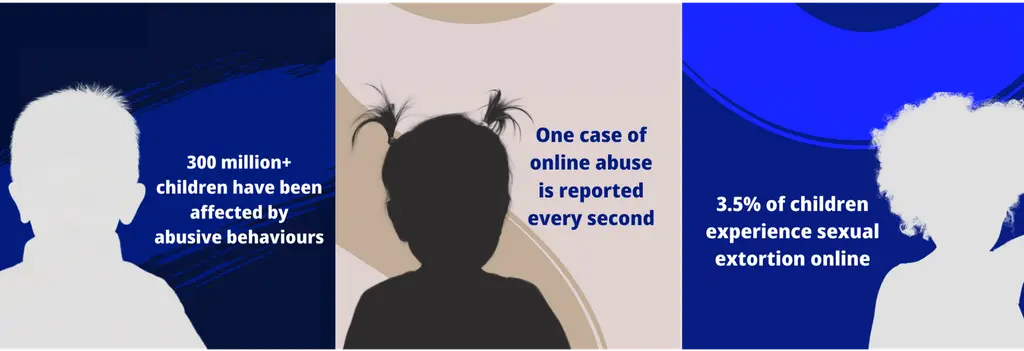Sensitive content
This site contains sensitive content that includes references to sexual violence.
Brave Movement

This legislation is one of the first serious attempts to modernize U.S. laws to protect children.
It specifically targets the distribution and threats of sharing non-consensual intimate images - including AI-generated content - as a federal crime, protecting survivors from further harm and ensuring that there are no loopholes for perpetrators based on location.
Over 300 million children under the age of 18 have been affected by online child and sexual exploitation and abuse in the last 12 months. As the home to many of the world’s leading tech companies, the United States holds a unique position of responsibility and influence in shaping online child protection standards.
With its vast technological infrastructure and global reach, the U.S. has both the tools and the moral imperative to lead efforts that ensure the internet is a safer place for children everywhere.
Currently, survivors face a patchwork of state laws protecting them from non-consensual intimate imagery, and tech companies and social media platforms are often slow to respond or unresponsive to removal requests, perpetuating the harm to survivors.
The TAKE IT DOWN Act criminalizes the act of intentionally publishing or threatening to publish non-consensual intimate images, including AI-generated content, on online platforms. Platforms would be legally required to remove flagged content within 48 hours of notification. Quick takedowns help minimize the emotional, reputational, and even physical damage caused by harmful content. Violence, which might start in an online sphere, negatively impacts children in the physical world, such as bullying in school or acts of sexual violence physically perpetrated offline.
"The federal criminalization of threats to disseminate and the dissemination of NCII is crucial for holding these platforms accountable for the content published and disseminated on their sites."
This bill puts the onus on tech companies and puts them on notice that they must engage and work to take down content expeditiously. With the threat of legal consequences, platforms would have more incentive to actively prevent and respond to exploitation and abuse.
"Combating sexual abuse must be addressed on all fronts, particularly on social media and the Internet. The "Take It Down" Act will not only help survivors in their pursuit of justice but will also prevent further abuse."

Alarmingly, 1 in 8 children globally have been subjected to online solicitation, and 1 in 8 children have experienced taking, sharing, and or/exposure to sexual images and videos in the last 12 months. Online sexual violence can have serious emotional, health, and psychosocial impacts on children and youth, including into adulthood.
"I was a victim of technology-assisted child sexual abuse when I was 13 … It's been 21 years since my abuse, and I still live in fear of those images. The images will never stop. There is no end date to this abuse…"
The TAKE IT DOWN Act reinforces accountability for tech companies in two ways. Firstly, by mandating tech and social media platforms remove non-consensual intimate images. Secondly, it gives survivors, including minors, a legal pathway to request takedowns of their own images.
Importantly, the bill also clarifies that consent to create an intimate image does not mean consent to publish the image, recognizing that children may engage in natural, age-appropriate or consensual exchanges with peers and clarifies that consent is key.
This bipartisan bill, passed by the Senate, and most recently cleared by the House Energy and Commerce Committee, now awaits a vote on the House floor before it can be sent to the President’s desk and signed into law. Over 185 organizations, including Together for Girls and the Brave Movement, have called on House leadership to quickly bring the legislation to the House floor for a vote.
U.S. leadership is critical not only to safeguard children domestically, but also to set a global benchmark for safety, accountability, and innovation in digital spaces.
It signals powerful political will –nationally and globally– regarding the adoption of survivor- and child-centered laws. This is a critical step forward in prioritizing the safety and well-being of children both in the digital world and offline.
In the US, advocates can support legislation like the TAKE IT DOWN Act by amplifying the voices of survivors, contacting policymakers, and raising awareness.
Globally, individuals can engage with trusted organizations working on child protection, push their governments to make reforms, and promote survivor-informed and evidence-based digital literacy and safety education in their communities. Tech professionals can help by building safety features into products and supporting ethical innovation. Parents, educators, and caregivers can stay informed, talk openly with children about online risks, and use available tools to protect their digital environments.
Ultimately, creating a safer internet is a shared responsibility—one that crosses borders, sectors, and generations.
Read the letter to the U.S. House of Representatives in support of the Take It Down Act that the Brave Movement has signed on to in partnership with dozens of other U.S. civil society organizations.
